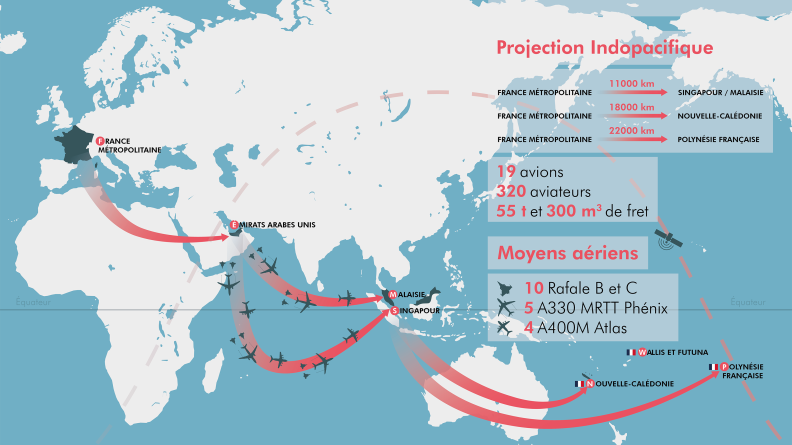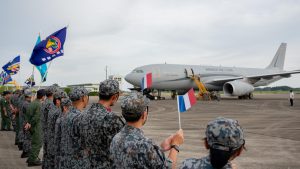“Jamais deux sans trois,” or “all things come in threes,” as the saying goes. After the 2018 and 2022 editions, the French Air Force deployment “Pegase 23,” named after a Greek mythological flying horse, is back in the Indo-Pacific. Amid the recent regional initiatives from President Emmanuel Macron, this military operation was the largest and most ambitious ever undertaken by the French army in the Indo-Pacific. It confirms France’s willingness to appear as a legitimate regional power.
From June 25 to August 3, the French Air and Space Force deployed 19 aircraft, 320 airmen, and 55 tons of freight across the Indo-Pacific. Starting from France, the mission included 11 stopovers and 14 operational maneuvers with several partner air forces: the United Arab Emirates, Singapore, Malaysia, Indonesia, Qatar, Djibouti, South Korea, and Japan.
The mission was divided into three major phases.
From June 25 to 28, 19 aircraft (10 Rafale fighter jets, five A330 MRTT refueling and military transport planes, and four A400M military transport aircraft), flew from France to Southeast Asia – a distance of 11,000 kilometers – with a technical stopover at the French base in the UAE.
From July 2 to 21, the French forces participated in multiple military exercises including Northern Edge and Talisman Saber, from the island of Guam, a U.S. territory. On July 10, in cooperation with the U.S. coast guard, a French A400M aircraft was involved in a real search and rescue mission around the Mariana Islands.
Several aircraft were also sent to the French territories in the region, New Caledonia and French Polynesia, during Macron’s visit.
Finally, from July 24 to August 3, while returning to France, multiple stopovers were made in South Korea, Japan, Indonesia, Qatar, and Djibouti, with joint military drills organized with local forces.

This map provided by the French Ministry of Defense shows the route taken by the Pegase 23 mission.
Pegase 23 fits into a broader strategic context. Since 2018, Macron has formalized a strategy for the French Indo-Pacific to legitimize and enhance French assets in the region.
The exercise of national sovereignty in the French collectivities of the region (New Caledonia, French Polynesia, La Réunion, and Mayotte) confers a multidimensional strategic depth. France has a 10 million square kilometer Exclusive Economic Zone (EEZ) in the Indo-Pacific, giving France the second largest total EEZ in the world, after the United States. Also in the region are 14 million square kilometers of airspace under the responsibility of the French authorities and a network of satellite stations essential for its space policy. But these assets also compel the French authorities to take measures to ensure the defense of these territories and enforce national sovereignty.
Thus, air diplomacy missions like Pegase give credibility to and strengthen the strategic objectives implemented by the French political authorities. The French Air and Space Force demonstrated its ability to engage Rafale fighters nearly 20,000 kilometers away from their home base in 48 hours, conducting large-scale air operations capable of reaching any point in the Indo-Pacific area in a minimum of time.
For more than a decade, French military air projections have undergone a considerable evolution through the combined engagement of Rafale/MRTT/A400M aircraft, allowing in-flight refueling and long-distance projection in a short time.
Amid other deployments like missions Shikra, Skyros, or Heifara, the Pegase mission aims to demonstrate the capacity of permanent reactive projection of forces and guarantee France’s freedom of action.
The other French armed forces also carry out similar military diplomacy missions, particularly the French navy (Marine nationale). The aircraft carrier Charles de Gaulle frequently conducts deployments in the Indian Ocean; in the past 10 years, it has been escorted by 42 ships of 12 different national navies.
These regular missions reinforce a permanent military presence composed of five military bases in New Caledonia, French Polynesia, La Réunion, Djibouti, and Abu Dhabi, where 7,000 French military are posted year-round.
Since the AUKUS partnership and the cancellation of the Australia-France submarine deal, French diplomacy has reoriented itself toward the strengthening of ties with key partners in the region.
Notably, the visit of Prime Minister Narendra Modi to France during the national Bastille Day holiday on July 14 reflected the long-term strategic partnership between France and India, which has been reinforced by the new Indo-Pacific narrative adopted by the two governments.
Singapore is also an essential partner for the French armed forces, bustressed by a strategic partnership since 2012 and a mutual logistical support agreement signed in 2022. Since then, the city-state has been a gateway for all the operational deployments of the French forces in the region. Indeed, Singapore stands out as an effective air-sea support and logistics stopover. In addition, Singapore stands as one of the most influential capitals in Southeast Asia, with world-renowned think tanks. Highlighting this point, a seminar was organized by the S. Rajaratnam School of International Studies at Nanyang Technological University when the Pegase mission made a stop in Singapore.
Finally, Indonesia confirmed in 2022 that it would purchase 42 Rafale aircraft and 12 Mirage 2000 from France. Apart from arms exports, a strategic defense partnership was signed in 2021, and regular ministerial meetings in the 2+2 format have been organized.
While developing regional partnerships and strengthening military capacities, the French armed forces also support the export of French military equipment. In 2022, France was the second largest worldwide arms exporter. It is therefore no coincidence that most of the Pegase stopovers were made in countries that buy or plan to buy French equipment (Qatar, the UAE, Singapore, Indonesia, and Malaysia).
Amid growing China-U.S. rivalry in the Indo-Pacific region, France, a European nuclear power, member of the U.N. Security Council, and the last EU state with territory in the region, is trying to appear as an alternative, balancing Indo-Pacific power. The recent statements made by Macron on the Taiwan issue confirm this stance: “The worst thing would be to think that we Europeans must become followers on this topic [Taiwan] and take our cue from the U.S. agenda and a Chinese overreaction.”
In the quest for strategic autonomy, the Pegase mission demonstrated a long-range capacity for intervention and projection of the French air force. Nevertheless, at the operational and tactical levels, the mission also highlighted an increased dependency on key partnerships in the region, specifically the United States. The Pegase deployment spent more than half of the mission on American soil. At the same time, no joint maneuver with the Chinese air force was carried out.
Clearly, French balancing is not equidistance.

































